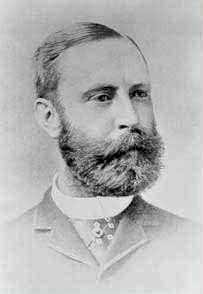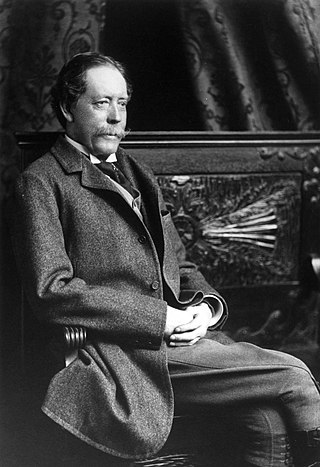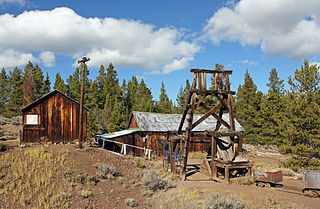
Jerome B. Wheeler was president and partner of R. H. Macy & Company in New York City and was an owner of mines, a hotel, and other businesses in Colorado.

Jerome B. Wheeler was president and partner of R. H. Macy & Company in New York City and was an owner of mines, a hotel, and other businesses in Colorado.
Jerome Byron Wheeler was born September 3, 1841, in Troy, New York, to Daniel Barker Wheeler and Mary Jones Emerson, both of Massachusetts. His mother was a second cousin of Ralph Waldo Emerson. His family moved to Waterford, New York, when Wheeler was young. He attended public school there until the age of 15. He obtained a clerical position in 1856. From 1857 to 1861 he pursued mechanical trades "which may have included engineering, mechanical, or machine shop work." [1]

Wheeler enlisted as a private in the 6th Regiment New York Volunteer Cavalry on his 20th birthday and at the beginning of the Civil War. He trained in Staten Island, New York, and was stationed in Washington, D.C., before obtaining his horse with the rest of the regiment in Cloud Mills, Virginia. The regiment fought throughout the Shenandoah Valley and during General George McClellan's Peninsular campaign. Wheeler was made second lieutenant under Colonel Thomas Devin and moved up the ranks and was made a colonel. Going against the "wishes of his superiors", Wheeler brought supplies to a group of starving Union Army soldiers who were positioned behind enemy lines. Considering the effort too dangerous, his rank of colonel was "reputedly" revoked. He mustered out of the army in September 1865. [1]
After the war, Wheeler returned to Troy, New York and worked as a bookkeeper. Wheeler moved to New York City about May 1866 and took a clerical position at John F. Barkley and Company, a grain merchant. He worked at Holt and Company, a large flour and grain commission house, starting in 1869 as a bookkeeper. He had several positions before becoming a full partner in the firm after 10 years at the firm. [1]
Wheeler married Harriet Macy Valentine in 1870. She was a descendant of Thomas Macy, one of the first European settlers in Nantucket, and niece of Rowland Hussey Macy who founded the R.H. Macy and Company, which became a large department store in New York City. In 1879, a few years after Rowland Hussey Macy's death, Charles Webster brought Wheeler in to be a 45% partner in the purchase of the department store. He remained a partner until 1888, when there was stiff competition from other department stores with fruitful advertising campaigns. [1]
Wheeler died in Colorado in December 1918. He is interred at Woodlawn Cemetery in the Bronx, New York City.
In 1883 Wheeler visited Colorado and "fell in love with the Colorado mountains". [2]
He decided to invest in "productive mines" in Aspen and Leadville. [3] Within Aspen, Wheeler purchased mines and built a tramway to bring ore down the mountain where it was processed in a smelter he built at the base of the mountain. [4] The smelter was owned by the Aspen Smelting Company. Wheeler was president of the Croseus Gold Mining and Milling Company. [3] He spent nearly one million dollars each to build the Hotel Jerome and the Wheeler Opera House. He also invested in the Colorado Midland Railway [4] and in 1885 became a director of the organization. [3] In 1888, Wheeler had the Wheeler-Stallard House built, but never lived in the home. [5] Wheeler also built a mountain tramway and a bank in Aspen. [3]
He was president of the Rock Hill Consolidated Gold and Silver Mining Company. [3]
Wheeler moved to Manitou Springs, Colorado, in an effort to improve his wife's health. [6] She had a severe case of bronchitis. [3] Wheeler built the Wheeler Bank in 1888, the town's first financial institution, and the Manitou Mineral Water Company, which bottled and shipped mineral water across the country, including New York's Waldorf Astoria Hotel. [2] [3]
In 1893, Wheeler built the Windemere estate in Manitou Springs, which included a conservatory, coach house, billiard rooms and bowling alley. He invested in the Manitou and Pike's Peak Railway, a cog railway that transported passengers to the top of Pikes Peak. [3]
Wheeler's mines in Leadville and Aspen made about $5 million in the 1880s. Much of his fortune was lost in the economic depression of 1893. [2] [3]

Leadville is a statutory city that is the county seat, the most populous community, and the only incorporated municipality in Lake County, Colorado, United States. The city population was 2,633 at the 2020 census. It is situated at an elevation of 10,158 feet (3,096 m). Leadville is the third highest incorporated city in the United States behind Alma and Montezuma and is surrounded by two of the tallest peaks in the state.

James Benton Grant was an American mining magnate, mining engineer, Confederate Army soldier who served as the third Governor of Colorado from 1883 to 1885.

William Jackson Palmer was an American civil engineer and veteran of the American Civil War. During the Civil War, he was promoted to brevet brigadier general and received a Medal of Honor for his actions.

The Colorado Silver Boom was a dramatic expansionist period of silver mining activity in the U.S. state of Colorado in the late 19th century. The boom started in 1879 with the discovery of silver at Leadville. Over 82 million dollars worth of silver was mined during the period, making it the second great mineral boom in the state, and coming 20 years after the earlier and shorter Colorado Gold Rush of 1859. The boom was largely the consequence of large-scale purchases of silver by the United States Government authorized by Congress in 1878. The boom endured throughout the 1880s, resulting in an intense increase in both the population and wealth of Colorado, especially in the mountains. It came to an end in 1893 in the wake of the collapse of silver prices caused by the repeal of Sherman Silver Purchase Act.

Horace Austin Warner "Haw" Tabor, also known as The Bonanza King of Leadville and The Silver King, was an American prospector, businessman, and Republican politician. His success in Leadville, Colorado's silver mines made him one of the wealthiest men in Colorado. He purchased more mining enterprises throughout Colorado and the Southwestern United States, and he was a philanthropist. After the collapse in the silver market during the Panic of 1893, Tabor was financially devastated. He lost most of his holdings, and he labored in the mines. In his last year, he was the postmaster of Denver.
David Halliday Moffat was an American financier and industrialist.

James John (J.J.) Hagerman was an American industrialist who owned mines, railroads and corporate farms in the American West in the late 19th and early 20th centuries. He was one of the most influential men in territorial New Mexico.
Eben Smith was a successful mine owner, smelting company executive, railroad executive and bank owner in Colorado in the late 19th century and early 20th century.

Ashcroft, originally known as Castle Forks City then Chloride until 1882, was a mining town located ten miles (16 km) south of Aspen, Colorado, United States. A few buildings remain standing as a testament to the town's past.

Louis Davidson Ricketts was an American economic geologist, metallurgist, mining engineer and banker who pioneered development of copper mines in the U.S. state of Arizona and the Mexican state of Sonora.
Silver mining in Colorado has taken place since the 1860s. In the past, Colorado called itself the Silver State.

The Leadville mining district, located in the Colorado Mineral Belt, was the most productive silver-mining district in the state of Colorado and hosts one of the largest lead-zinc-silver deposits in the world. Oro City, an early Colorado gold placer mining town located about a mile east of Leadville in California Gulch, was the location to one of the richest placer gold strikes in Colorado, with estimated gold production of 120,000–150,000 ozt, worth $2.5 to $3 million at the then-price of $20.67 per troy ounce.

Frederic Anton Eilers was an American metallurgist and smelting and refining entrepreneur who co-founded the American Smelting and Refining Company, known today as ASARCO.

The Wheeler Opera House is located at the corner of East Hyman Avenue and South Mill Street in Aspen, Colorado, United States. It is a stone building erected during the 1890s, from a design by Willoughby J. Edbrooke that blends elements of the Romanesque Revival and Italianate architectural styles. In 1972 it became the first property in the city to be listed on the National Register of Historic Places, and the second in Pitkin County. The upstairs auditorium hosts a number of events every year, ranging from nationally prominent music and comedy acts and some of the Aspen Music Festival's events to productions by local community groups.

The Wheeler–Stallard House is located on West Bleeker Street in Aspen, Colorado, United States. It is an 1880s brick structure built in the Queen Anne architectural style, and renovated twice in the 20th century. In 1975 it was listed on the National Register of Historic Places.

The Hotel Jerome is located on East Main Street in Aspen, Colorado, United States. It is a brick structure built in the 1880s that is often described as one of the city's major landmarks, its "crown jewel". In 1986 it was listed on the National Register of Historic Places. It is operated by Auberge Resorts.

The Holden/Marolt Mining and Ranching Museum is located on the former Holden Lixiviation Works facility on the western edge of the city of Aspen, Colorado, United States. It consists of two remaining buildings from the facility, as well as the relocated McMurchy/Zupancis domestic buildings. In 1990 the property was recognized as a historic district and listed on the National Register of Historic Places, the only district in the city to be so recognized.

The Smuggler Mine is located on the slopes of Smuggler Mountain, on the north edge of Aspen, Colorado, United States. It is the oldest operating silver mine in the Aspen mining district, and one of the few still operating from Aspen's early boom years. In 1987 it was listed on the National Register of Historic Places.

Manitou Mineral Springs are natural mineral springs in Manitou Springs, Colorado and Cheyenne Spring House is on the National Register of Historic Places. The springs are located in one of the country's largest National Historic Districts.

Iron Springs, a neighborhood in Manitou Springs, Colorado, was an area named for one of Manitou Mineral Springs. The Manitou area had been frequented by Native Americans who considered it a sacred and healing place before European Americans settled in Manitou.